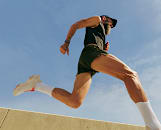
Strelciuc Dumitru / iStock / Getty Images Plus via Getty Images
Why You Might Have Shoulder Pain During Push-Ups—and How to Address It
Good form is key to preventing this annoying push-up symptom, experts say.
By Kathleen Felton•
Why You Might Experience Shoulder Pain When Doing Push-Ups
How to Deal with Shoulder Pain from Push-Ups
How to Prevent Shoulder Pain During Push-Ups
The Takeaway
If you want a challenging yet extremely effective exercise, look no further than the classic push-up. This simple bodyweight movement targets multiple muscles, including those in your core, chest, triceps, and shoulders, all without requiring any weights or special equipment.
Discover more ways to reach your goals with Peloton
Push-ups may look basic, but anyone who has done even one knows they can be hard—especially because the move places a lot of pressure on your shoulder joint, says James Bicos, MD, a sports medicine orthopedic surgeon with Corewell Health. As a result, some people experience shoulder pain when doing push-ups, he explains. This can be both uncomfortable in the moment as well as frustrating when you’re trying to complete extra reps.
Here’s what to do if you notice that push-ups are causing you shoulder pain, plus how to prevent it from happening in the future.
Why You Might Experience Shoulder Pain When Doing Push-Ups
The shoulders are vulnerable to pain during exercises like push-ups partly due to the physiology of this area, Dr. Bicos explains.
“The shoulder joint is literally like a marble on a table, and we have static structures like cartilage and bone that provide some stability,” he says. “But because of this range of motion, we also need the stability of the muscles to keep it in place.” When you do a push-up, “immense compressive forces” are placed on the shoulder joint, he says. This can cause pain in the moment, since the shoulder is essentially being compressed to maintain that stability.
Shoulder pain during push-ups can also be caused by muscle fatigue (think “normal” workout pain—you’ve exercised a lot lately, and those muscles are sore). You might be especially prone to shoulder soreness if you’ve been combining push-ups with other arm exercises, says Meghan Rohde, a board-certified sports physical therapist at Revolution Wellness Collective. “If there are other upper body movements paired with push-ups that involve a similar pushing motion, those muscles can fatigue quickly and form will begin to break down.”
Improper form can also cause shoulder pain that you’ll eventually feel during a push-up. “In the anterior shoulder, the biceps and pec major and minor all attach in a similar area,” Rohde says. “Those muscles work together to provide the primary movement for the push-up, but if posture is forward or arms are out too wide, there isn’t much space for those muscles to do their job.” These form mistakes could lead to biceps tendonitis (a condition characterized by inflammation in your upper biceps tendon) or impingement (which occurs when your shoulder bones pinch your rotator cuff), two frequent causes behind shoulder pain, she adds.
Other times, shoulder pain when doing push-ups may be due to an injury, such as muscle or tendon tears like rotator cuff tears, or sometimes lateral tears, according to Dr. Bicos.
Luckily, it’s not super common to experience shoulder pain during push-ups, experts say, but it can happen.
How to Deal with Shoulder Pain from Push-Ups
Even if it’s just a dull ache, pain in your shoulder when doing push-ups is usually a sign that something isn’t working right. Follow these steps to try to troubleshoot the issue:
1. Check Your Form
Shoulder pain during push-ups can stem from poor form, so the first thing to do is review your technique, Dr. Bicos says. When doing a push-up, you should:
Start in a high plank position, with your hands under your shoulders and your feet hip-distance apart.
Spread your fingers out for better grip, and engage your core to prevent an arched back.
Make sure your elbows are fairly close to your body—about a 45-degree angle—then slowly lower your chest down. Pull the shoulder blades down as you do this.
Once you’re at the bottom, push yourself back up in a straight line. Keep your elbows rotated in toward the mat (instead of pointing out) as you exhale and push up.

2. Don’t Be Afraid of Modifications
If your form is good and you still feel soreness, you might consider modifying your technique. “Sometimes if you are just getting into working out, push-ups can be very difficult,” Dr. Bicos says. “So, you can start doing push-ups on your knees rather than from a true plank.” This position puts less pressure and weight on your shoulders.
3. Switch up Your Movements
Shoulder pain from overuse may benefit from cross training, Dr. Bicos says. You might need to swap in other moves that put less pressure on your shoulders for a couple of weeks, he notes. That might include other shoulder exercises like dumbbell frontal raises and dumbbell lateral raises, which target these muscles without using the same pushing motion.
4. Check In with a Healthcare Provider About Lingering Pain
Achy shoulder pain that goes away within a day is usually nothing to worry about, Dr. Bicos says. But if any of the red flags below describe your pain, you should make an appointment with your healthcare provider:
The shoulder pain you’re feeling is sharp
The pain lasts more than three days, or lingers every time you try to do a push-up
You find that you start having shoulder pain with everyday activities
You can’t lie on that side to sleep, or the pain wakes you from sleep
You can see a physical therapist without a referral, Rohde notes, and they can be particularly helpful for pain that’s the result of movement. Your doctor might also recommend a shoulder specialist or an orthopedic sports medicine surgeon to help to rule out other major injuries, like rotator cuff tears or labral tears.
Related Articles

Stretching + Mobility
Why You Need to Build Shoulder Mobility—and 6 Exercises to Do Just That

Stretching + Mobility
10 Stretches to Target Tight Shoulders

Strength Train
15 Push-Up Variations to Master at Every Level of Your Fitness Journey

Strength Train
Want to Strengthen Your Shoulders? Grab Your Dumbbells—and Try These 5 Exercises
How to Prevent Shoulder Pain During Push-Ups
Take care of that shoulder joint and reduce the chances that you’ll develop pain in the future by following these strategies:
Warm up and cool down. Even though you’re not about to jump on a bike or head out for a run, push-ups still warrant warm-up exercises, Dr. Bicos says. Make time to do some upper body stretches when you’re done too.
Always use proper form. When you do a push-up, engage your core and glutes, Rohde says, and ensure your shoulder blades stay back and down to minimize impingement in the front of the shoulder. Your neck should be neutral, neither looking up or down, Dr. Bicos says.
Give yourself rest days. Doing the same exercise every day can lead to soreness or overuse, so make sure to give yourself proper breaks, particularly if you’re experiencing pain. Experts generally recommend taking one or two rest days a week.
Don’t push it if something hurts. “The most common mistake is not ‘listening’ to your body,” Dr. Bicos says. “For many people, the mantra is ‘no pain, no gain,’ and that it should hurt to get better.” But that’s not accurate: A true, sharp pain can signal a deeper issue and is a sign to slow down.
The Takeaway
Shoulder pain when doing push-ups isn’t a super-common complaint, but it can happen to some people, especially because you’re putting quite a bit of pressure on your shoulder joint during this challenging bodyweight exercise. To prevent it from happening in the future, experts recommend keeping a close eye on your form: Your core and glutes should be tight, your shoulder blades back, and your neck in a neutral position. And always listen to your body: If something doesn’t feel good when doing push-ups (or any exercise, for that matter), take a break, talk to your doctor, and give your body a chance to recover before pushing (no pun intended) on.

Peloton App
Access thousands of classes with no equipment needed.
This content is for informational and educational purposes only and does not constitute individualized advice. It is not intended to replace professional medical evaluation, diagnosis, or treatment. Seek the advice of your physician for questions you may have regarding your health or a medical condition. If you are having a medical emergency, call your physician or 911 immediately.
Build full-body strength
Enter your email to get articles, instructor tips, and updates from Peloton sent to your inbox.
By providing your email address, you agree to receive marketing communications from Peloton.
For more about how we use your information, see our Privacy Policy.





